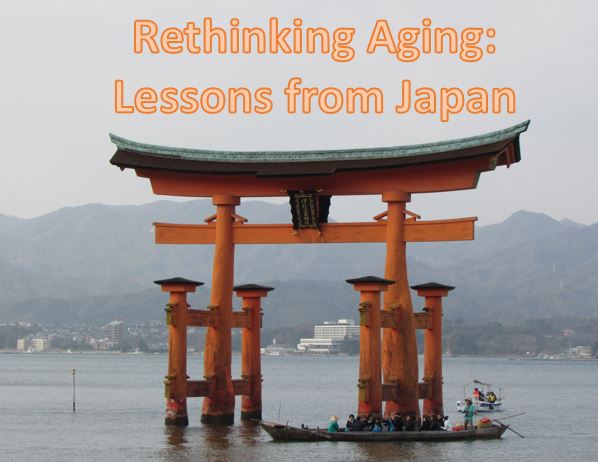We are always looking for innovations that can lead to healthier, happier and more productive aging. Rethinking aging will also be vital to the health of our workforce and the ability to thrive as a graying society. Japan’s unprecedented aging population presents important examples of challenges and opportunities for rethinking aging.
One in four Japanese people is over the age of 65 (compared to 15% in the U.S.). Their population pyramid is skewed, with larger numbers of older people and low birth rates. This is considered especially problematic for the workforce and economic output of the country since, by 2050, there will be just one working-age Japanese for every elder or child. For a county unlikely to turn to immigration to meet these needs, Japan has had to start rethinking aging and innovative solutions.
Rethinking Working and Retirement: Solving Human Capital Shortages with Older Adults
To address the shrinking workforce, Japan is steering elders away from retirement back into the job market and providing ways to make this more feasible and attractive. Automation and smart workplace solutions can stretch the labor force and accommodate older workers. A recent Wall Street Journal article shared one such story of Mr. Saito, a construction worker who wears a specially designed exoskeleton that supports his movement and cuts the load of lifting heavy objects. In this way, his company is supporting his extended working life and ensuring they have the employees to keep their building projects going.
Japan is facing this graying of the population due to low birth rates, but also healthier aging. Not only does Japan have a high life expectancy, they have the world’s highest “healthy life expectancy” (the age a person can reach living independently). Given this trend, which is likely in many developed nations, we will need to rethink assumptions about later life and even common practices and services.
About one in five elders work in Japan, which has helped keep the workforce from shrinking as expected. The pilot retirement age was recently raised to 67 and the construction industry is bringing on record numbers of older workers. Like in the U.S., there’s a shortage in the nursing care sector, which elderly workers are also playing a crucial role. Healthy elders can be a true asset in caring for older, less healthy elders.
Japan’s Living Natural Treasures program (formally called Preservers of Important Intangible Cultural Properties) recognizes the value of intangible culture, often kept alive by older adults. These are people who preserve certain arts and practices that are special to Japan (such as ceramics, textiles, and many kinds of performing arts). Not only do these individuals and groups get a special designation, but the government actually puts money into this program to help support the continuation of these aspects of culture with grants. What a truly great way of appreciating the richness of culture and history that older adults lend to any society!
Turning to Technology for Aging Solutions
Japan’s also turning to robotic technology for help with workforce issues and unfilled demands. In addition to the exoskeletons, robots can be used to extend the workforce (robots serve diners at restaurants and even greet customers at a hotel in Japan) and even help with care tasks. The Japanese-invented robot Pepper, capable of reading human emotions, has been successfully used as a nursing helper. A Toyota Corporation invention allows distant loved ones to perform tasks for elders with a combination videophone and Android (we have some cool monitoring options in the U.S. but have yet to see the release of something with the robotic piece to complete tasks).
This should be something we start to see more of in the eldercare field, though right now even available technologies like PERS/monitoring and electronic pill machines are underutilized. This will likely change out of necessity, but tech companies also need to carefully study issues of need and usability.
Targeting the Consumer Potential of Elders with Appealing/Needed Products and Services
Japan’s older generation is also having a big effect on the consumer market. Companies are investing in products and marketing to target this demographic. A couple of interesting examples include the surge in home remodeling to make homes more “aging in place friendly” (care in facilities is quite rare in Japan) and meal delivery services (7-11 delivers meals to almost a million homes). Businesses are also repackaging products and services, allowing them to make up for lagging consumer spending by tapping into the elder market.
Lessons Learned for Rethinking Aging
There are some interesting stories and examples here, but more importantly there are lessons we can take away as individuals, companies and a society about rethinking aging in our modern era. First, we need to challenge traditional assumptions and possibly even change laws, regulations and policies (everything from retirement ages to aspects of Social Security, healthcare and labor laws/taxes). Second, technology will be an essential part of a successful aging society.
Human capital, experience and knowledge have real value and we need to find ways to actively support the value of older adults as workers and otherwise. Additionally, companies can tap into the huge potential of older consumers with smart product and service development and marketing (smart being the key word here!). Just like the “sharing economy” has turned industries on their heads (i.e. Uber and Lyft for transportation and AirBnB for accommodation), industry leaders will need to innovate to both appeal to and meet the needs of a graying population.
Sign up for our newsletter for more on rethinking aging. We’ll be keeping you up-to-date on the latest innovations and news so don’t miss out!

